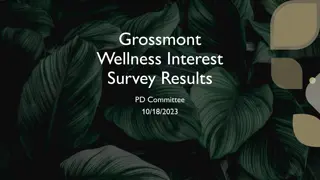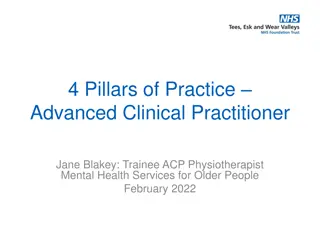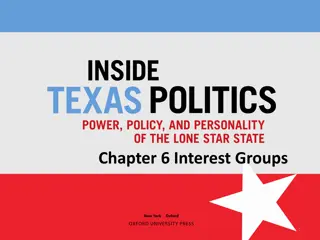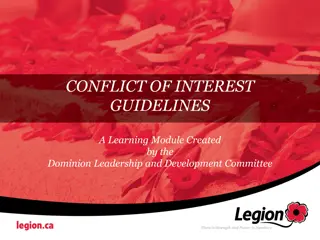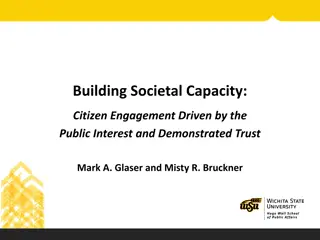Communities of Interest and Practice
Communities of Practice, led by Honorary Associate Professor Jacquie McDonald, focus on shared interests and knowledge exchange for effective learning. Explore elements like domain sharing, community growth, and shared practice to enhance learning experiences. Discover how members engage in sustained conversations around teaching and learning, fostering a culture of collaboration and innovation within their fields. Find inspiration in the University of Southern Queensland's pioneering CoP model, facilitating professional growth and resource sharing among faculty members.
Download Presentation

Please find below an Image/Link to download the presentation.
The content on the website is provided AS IS for your information and personal use only. It may not be sold, licensed, or shared on other websites without obtaining consent from the author.If you encounter any issues during the download, it is possible that the publisher has removed the file from their server.
You are allowed to download the files provided on this website for personal or commercial use, subject to the condition that they are used lawfully. All files are the property of their respective owners.
The content on the website is provided AS IS for your information and personal use only. It may not be sold, licensed, or shared on other websites without obtaining consent from the author.
E N D
Presentation Transcript
Communities of Interest Communities of Interest and Practice and Practice Honorary Associate Professor Jacquie McDonald Higher Education Community of Practice Consultant Co-facilitator of an online community for social learning leaders: Co-researching the facilitation of social learning Email: mcdonalj@usq.edu.au With Communities of practice I know I m not alone
Elements of communities of practice Community Groups of people who share a concern or a passion for something they do and collectively learn how to do it better as they interact regularly. Domain Sharing Practice Wenger, 1998
Clarifying Community of Practice Elements A domain of knowledge that creates a common ground and sense of common identity (builds member capacity) A community of people who care about the domain and create the social fabric of learning (grow a learning community) A shared practice developed to become effective in the domain (innovations noted and this saves reinventing the wheel) Communities of Practice provide a context for members to engage in sustained conversations around learning and teaching, situated in their field of practice or interest area. Learning with not only learning from idea of joint enterprise
Learning from, with and for practice Learning
University of Southern Queensland Start-up First CoP at USQ in 2006 for Faculty of Business first year core course leaders, to cut across isolated discipline silos of teaching practice, share and improve L&T practice and build scholarly/research capacity, faculty based & co-facilitated Membership is voluntary, agenda focus determined and prioritised by members Approach evolved as a nurtured CoP, facilitation role key to success Three core CoP elements: community, domain knowledge and sharing practice: as agenda structure. Member driven, topic or cohort focused Time jealous, so value add to CoP activities, Toolkit for Faculty of Business First Year Core Course Leaders and HERDSA 2008 publications Professional identity, trusted members share and filter information, L&T resources, research and publications
Community of Practice Agenda Template Welcome and Community time - food & fellowship (30 minutes) Introductory activities & Learning Loops:(Title) (5-15 minutes) Sharing our practice:(Title & presenter)(30-40 minutes) Building our domain knowledge:(Title & presenter) (30-40 minutes) Learning Loops what are you taking away to try in your practice? Next meeting: ______(Date & time) ______ (Venue) Resources
CoPs are about collaborative learning Working together builds a trusted community where members share their knowledge to build their Learning & Teaching practice As educators we want to improve our ability to do our job, individually and collectively learning with and from colleagues CoP collaborative learning contributes to the learning culture & adds value for all stakeholders, members, the institution and profession Example: Toolkit for Faculty of Business First year Core Leaders, based on sharing of practice sessions profiling CoP and the members, making tacit knowledge visible Example: Members end of year presentation to Faculty, used stories and content as basis for joint presentation to HERDSA 2008 conference
Types of CoPs and contextual issues Type of CoP Organic Nurtured/supported Created/intentional Structure Bottom-up Modified bottom-up Top-down Support level Minimal Subsidised Provided Membership Voluntary Voluntary/suggested Encouraged Themes Discipline- related Self-determined Self-determined/steered Discipline or issue related Guided issues and cross discipline Guided theme Agenda Timing for outcomes Self-determined Self-determined & funding- related Short-term rather than long-term
Value of CoPs in professional higher education learning contexts short-term value long-term value help with challenges access to expertise confidence fun with colleagues meaningful work personal development reputation professional identity network marketability members problem solving time saving knowledge sharing synergies across units reuse of resources strategic capabilities keeping abreast innovation retention of talents new strategies organisation
Evolving social learning theory Wenger-Trayner & Wenger-Trayner (in press) Learning to Make a Difference: Volume I Value creation in social learning spaces expand the concept of a social learning space, which may include some of the features of a Community of Practice, but without the expectations of continuity and ongoing commitment. The features they highlight are: The focus is on people and their participation Members drive the learning agenda Learning is rooted in mutual engagement The engagement pushes the participants edge of learning Meaning and identity remain central, but based on caring to make a difference rather than competence in a social practice
Threats and risks to implementing CoPs Threats and risks to implementing CoPs Time for commitment to CoP facilitators and members Fad - Just another box to tick Top-down approach to implement management agendas Burden for members when CoP given just more procedural work Micro-management, with managers controlling direction & activities so CoP become usual business, taking away sense of ownership and energy Neglect CoPs marginalised and lacking institutional recognition Shifting priorities, change of leadership, budget pressures, lack of commitment and resourcing
Value & opportunities generated by CoPs Value & opportunities generated by CoPs End-client value Personal value Organizational value growth Sponsor value network practice Community value influence recognition
The Educator Network (tEN) moving forward: leveraging opportunities Strategic conversations to connect CoPs with institutional goals, and leveraging senior leadership to sponsor CoPs Cultivation of facilitation approach & practicing distributed leadership High expectations and visible presence such as The Educator Network (tEN) Engagement with members through consultation, listening to ideas, questions, challenges emerging from domain practice Adequate resources & dedicated CoP time for facilitators and members Recognition of CoPs contribution with public celebrations, activity profiling, tEN Showcase Events Opportunity for ongoing conversations and sharing of practice between formal gathering - To encourage collaboration the Educator Network has created a Yammer group to assist with sharing good practice, supporting ideas and creativity and networking.
McDonald, J. (2014). Community, domain, practice: Facilitator catch cry for revitalising learning and teaching through communities of practice. Final Report 2012 (published 2014). McDonald, J., Burch, T., Nagy, J., Star, C., Cox, M., D, Collins, E., & Margetts, F. (2012). Identifying, building and sustaining leadership capacity for communities of practice in Higher Education. Final report. Australian Government Office for learning and teaching. Sydney, Australia. McDonald, Jacquie, Cater-Steel, Aileen (Eds.) (2017) Communities of Practice: Facilitating Social Learning in Higher Education, Springer. ISBN 978-981-10-2879-3 http://www.springer.com/gp/book/9789811028779. McDonald, Jacquie & Cater-Steel, Aileen (Eds.) (2017) Implementing Communities of Practice in Higher Education: Dreamers and Schemers. Springer ISBN 978-981-10-2866-3. http://www.springer.com/gp/book/9789811028656. McDonald, J., Collins, P., Hingst, R., Kimmins, L., Lynch, B. & Star, C. (2008). Community learning: Members stories about their academic community of practice, in Engaging Communities, Proceedings of the 31st HERDSA Annual Conference, Rotorua, 1-4 July 2008: pp 221-229. Reaburn, P., & McDonald, J. (2017). Creating and Facilitating Communities of Practice in Higher Education: Theory to Practice in a Regional Australian University. In J. McDonald & A. Cater-Steel (Eds.), Communities of Practice - Facilitating Social Learning in Higher Education. Singapore: Springer. Tight, M. (2015). Theory application in higher education research: the case of communities of practice. European Journal of Higher Education, 5(2), 111-126. Wenger, E. (1998).Communities of practice:Learning, meaning, and identity. New York, US: Cambridge University Press. Wenger-Trayner, B., Wenger-Trayner, E., Cameron, J., Eryigit-Madzwamuse, S., & Hart, A. (2019). Boundaries and Boundary Objects: An Evaluation Framework for Mixed Methods Research. Journal of Mixed Methods Research, 13 (3), 321 338. Wenger-Trayner , E., & Wenger-Trayner, B.(in press). Learning to make a difference (Vol. 1: Value creation in social learning spaces). Cambridge, England. Cambridge University Press. Wenger, E., Trayner, B., & de Laat, M. (2011). Promoting and assessing value creation in communities and networks: A conceptual framework. Retrieved from http://wenger-trayner.com/resources/publications/evaluation-framework/
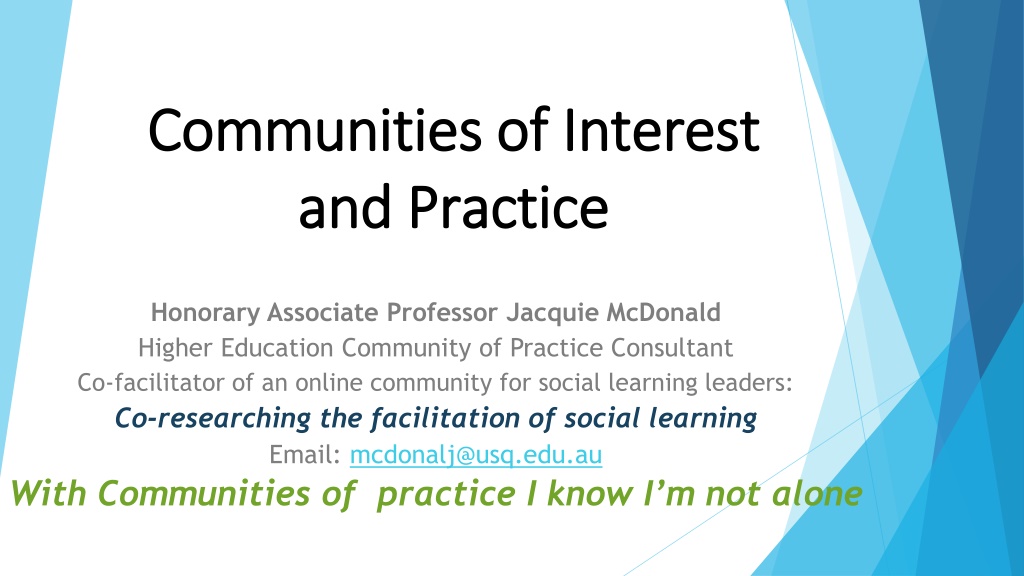
 undefined
undefined


